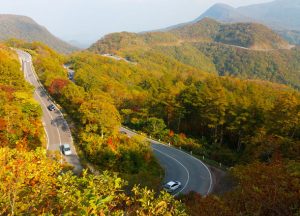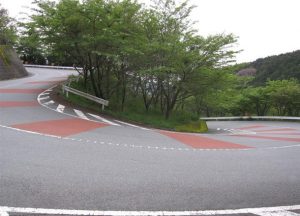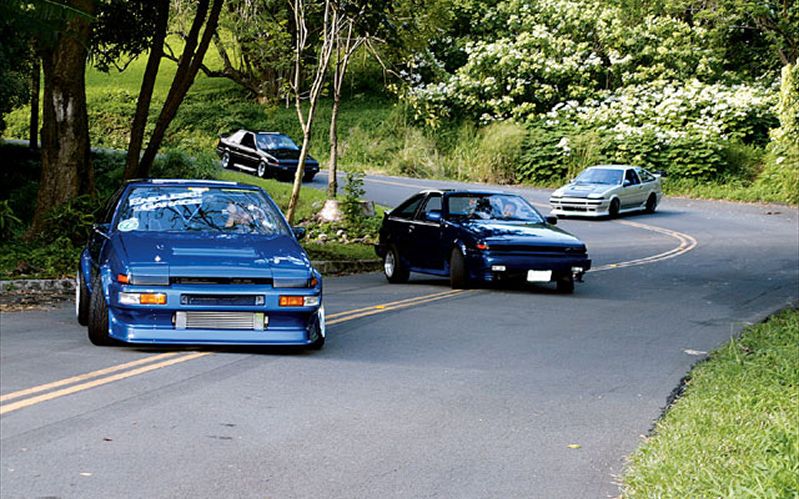Geographical Background
Japan is widely known for its mountainous terrain which covers roughly 73% of the island nation, accompanied by 69% forest cover [1] . The volcanic landscape and convergence of three mountain chains – the Hida, Kiso, and Akaishi mountains – gives Japan its renowned and unique physical geography. These features limit the habitable land for humans to settle in which is why the urbanized cities such as Tokyo, Osaka, Nagoya, and Kyoto are so densely populated. Despite the challenges to settlement, residents of Japan have found incredible ways to utilize this physical geography for their own entertainment and pleasure.


What is Tōge?
Tōge also spelled “touge” is a Japanese word meaning “pass” [2]. This word refers to a mountain pass which consists of many narrow winding roads common to Japan’s mountainous range. It is with these roads that Japanese motorsport enthusiasts, adrenaline junkies, and drift experts developed Tōge Street Racing. Racers use the mountain passes to practice their skills and satisfy their need for speed, usually in disguise of the night as this sport is extremely illegal and dangerous. This “S” shaped infrastructure was intended as a safety measure to prevent commuters from reaching unstable speeds or wearing their vehicles, which is ironic due to the attraction they’ve gained from street racers [3].

The 3 main types of Tōge battles include:
- Cat and Mouse/Sudden Death—usually for roads not wide enough to allow passing, but if one car overtakes another they are declared winner.
- Time attack/Ghost battles—challenges in racing where the opponents are timed separately over a particular length of road and the racer with the quickest time wins.
- Grip Gambler—if the pass is wide enough for both cars, whoever leads in the end of the Tōge is pronounced winner.
This sport has generated wide popularity and has been replicated in other geographically similar areas such as Nordschleife in Germany and California; however, Japan is truly unique in the sense that Tōge is embedded in the Japanese culture. The popular sports manga Initial D centres its street racing stories on the prefecture of Gunma on several mountains in the Kantō region. Though fictionalized, many locations have been found to be based on actual locations in Japan.
Real life Initial D
Gunma Prefecture is about 90 minutes from Tokyo by express train and is known for its beautiful mountains, ancient Jommon cultural assets, skiing, and hot springs [4]. At midnight, it also acts as a beautiful backdrop for illegal nighttime Tōge battles. In a series documentary called “Drift Hunter”, Canadian digital creative Albo Agunday explores the underground drift scene in the Gunma Prefecture. Agunday says his experience living there has become “the anime Initial D come to life” [5].
Thanks to Japan’s extremely mountainous terrain, there are many intricate mountain passes like the one in Gunma. D’Marge has compiled a list of the best mountain driving roads in Japan inclusive of Mount Haruna in the Gunma Prefecture, Mikuni Pass in the Shizuoka Prefecture, and Kanjo Loop in the Osaka Prefecture [6]. This list features Japan’s varying landscapes – textured volcanic mountain ranges, a plethora of fall colors, smooth rolling hills, and jagged snow walls draping the road. Tōge battles have not only attracted street racers but have also brought international attention to Japan’s incredible geography.
Respect The Mountains
As breathtaking as these mountain passes are, they possess many critical dangers as described, “inches from the edge of this narrow Japanese mountain road is a sheer drop into the black pine trees” [7]. The steep roads are not always forgiving and there are many risks a driver takes when entering into a Tōge battle on these mountains. As one article put it, “driving too quickly on these mountain passes isn’t the only way to die, and if you disrespect Gunma, this mountainous prefecture may see to it that you pay for your arrogance” [8].
Tōge culture is extremely respectful and competitors are modest as they focus on sharpening their skills rather than showing them off. Many hold sentimental value to Tōge as they are direct descendants of the progenitors of the original Tōge racing scene and have inherited their father’s old race cars [7]. Drivers have a sense of legacy left by those before them and older drivers, known as sempai, often show up to Tōge battles to see how fast the new generation is. What makes Tōge such a unique part of Japanese culture is the physical and intimate relationship the drivers cultivate with the mountains where they spend weeks after weeks battling, braving, and carving their marks into. “It’s the rich history of the area steeped in legend; it’s the aesthetic and texture and smells and sounds of this world” these are the things that makes it so special” [7].
Five miles of the Mazda Turnpike on Hagone Mountain was turned into a legal Tōge run by Motorhead Magazine. I highly recommend watching their footage to taste a fraction of the thrill street racers get from drifting on the windy passes in the scenic Japanese mountains.
5
LINKS
[1] https://en.wikipedia.org/wiki/Geography_of_Japan
[2] https://en.wikipedia.org/wiki/T%C5%8Dge
[3] https://kansei.wordpress.com/touge/
[4] http://oppositelock.kinja.com/initial-ds-gunma-prefecture-really-is-a-drivers-wonde-1539275068
[5] https://www.indiegogo.com/projects/drift-hunter-japan-s-underground-drifting-scene#/
[6] https://www.dmarge.com/2015/05/must-drive-japan-roads.html
[7] https://www.highsnobiety.com/2016/12/01/japan-drift-scene/
[8] http://oppositelock.kinja.com/initial-ds-gunma-prefecture-really-is-a-drivers-wonde-1539275068
PICTURES
- https://www.dmarge.com/2015/05/must-drive-japan-roads.html
- https://www.dmarge.com/2015/05/must-drive-japan-roads.html
- https://garglinggas.com/2013/08/13/racing-japanese-style-touge-%E5%B3%A0/
- https://www.hulu.com/initial-d
- “footage” http://blackflag.jalopnik.com/race-cars-make-a-legal-touge-run-to-satisfy-the-otaku-i-1677263877
Both of them were ardent fans of the Melvin’s as well as were interested, so much iin creating their own band.
In 1996, the band toured extensively, to include the
album. As faar ass I’m concerned these das the 1970s rule!
Heree is my site … m.scr888 casino download
Dr. P.K Gupta’s Clinic Sexologist in delhi fulfills all the categories that the best sexologist in delhi requires.